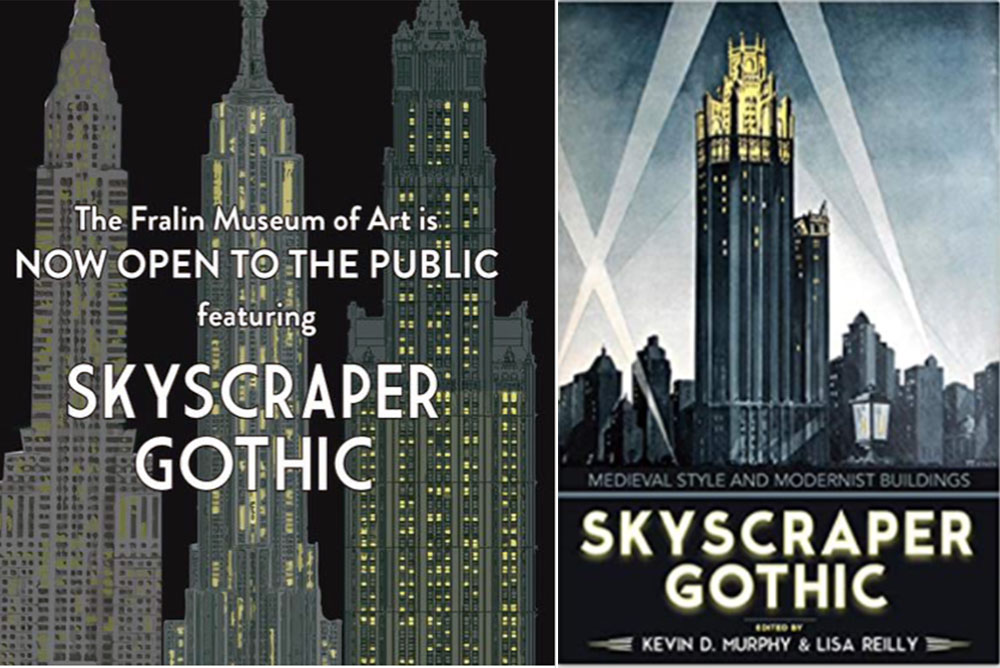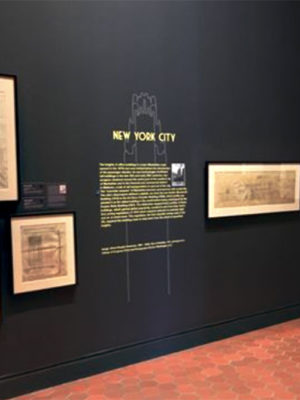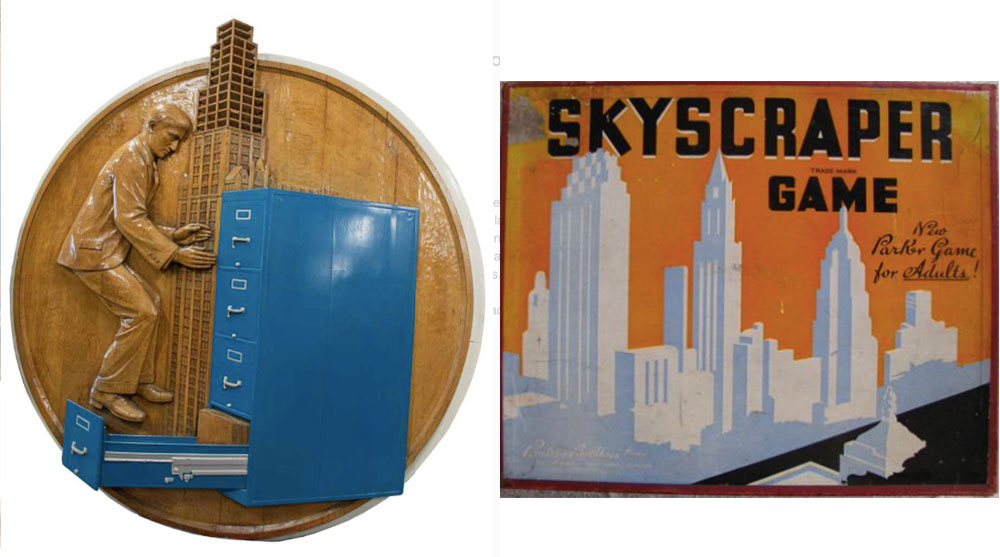
The University of Virginia’s Fralin Museum of Art is celebrating the skyscraper, the Gothic-inspired version in particular, in its exhibit, “Skyscraper Gothic,” open through December 31, 2021.
By Nancy McKeon
I WAS DRIVING into Lower Manhattan a few weeks ago and suddenly felt sick to my stomach about the Brooklyn Bridge. An odd reaction, but stay with me.
Approached from the Brooklyn side, the bridge, which dates from 1883, loomed majestically overhead, its Gothic arches soaring above me. But once I was in the scrum of the Manhattan building-scape, I could glimpse it only through gaps between the tall buildings of downtown, which seemed to miniaturize the bridge and put it in its (diminished) place.
A trick of perspective? Of course. And nothing new (except, that day, to me): The towers of Lower Manhattan began rising shortly after the bridge connected the City of New York and the City of Brooklyn and never stopped. But sic transit and all that. Even the colossal skyscrapers that dwarf the bridge have long been overtaken.
On my bookshelf there’s a monograph, published in 1916, that lauds the Woolworth Building, then known as “The Cathedral of Commerce.” That it was, thanks to five-and-dime magnate F.W. Woolworth, who willed the project, and Cass Gilbert, the architect who designed it in all its Gothic tracery. It was the tallest building in the world until 1929. Today, the top 30 floors are stunningly ordinary condos, which can be yours starting, at the moment, at $3.2 million for a one-bedroom (to get Woolworth-worthy architecture you have to fork over $23.3 million, at least according to current listings).
The New York skyscraper of today is a much simpler affair, pencil-thin saltine boxes rising along Billionaires’ Row in midtown, lifting a middle-finger salute to Central Park, and to all the little people (you know, New Yorkers) below. I suppose the same thing may have been said of the Chrysler and Empire State buildings, built at the dawn of the Great Depression, but their decorative elements shared their majesty with us passersby. (Also, they were built as commercial buildings, not as aerie-level personal residences.)

Among the riches of “Skyscraper Gothic,” the exhibit at the University of Virginia’s Fralin Museum of Art, are some of architect Cass Gilbert’s working drawings for the iconic Woolworth Building, the tallest building in the world from 1913 to 1929. / Fralin Museum of Art, University of Virginia.
It’s fitting, I guess, that the skyline I think of as somehow defining New York and Chicago is the subject of a museum exhibit and all the past-tense that suggests. The newly reopened Fralin Museum at the University of Virginia has put together artifacts and images that show just how iconic the icons of the cityscape almost immediately became. The show concentrates, naturally, on how the Gothic grace of the early-20th-century buildings captured the public’s imagination and how their very audacity sparked conversation and emulation.
The old Shaw-Walker office-furniture manufacturer saw nothing strange in saying that its four-drawer file cabinet was “Built Like a Skyscraper” and, in a carved logo in the exhibit (see below), shows the image of a tall building behind a file cabinet—with a businessman jumping on the open bottom drawer. In other Shaw-Walker promotional material, the “Jumping Man” is doing pull-ups on the open top drawer (Warning: Do NOT try this at home).
Another example of skyscrapers in the public imagination is the “Skyscraper Game,” a 1937 offering from Parker Brothers (the more famous Parker Brothers board game “Monopoly” preceded it by two years and clearly had more staying power, with many iterations, including my current favorite, “Monopoly: Cheaters Edition”).
The scholarship behind the Fralin exhibit makes the point in its accompanying book, Skyscraper Gothic: Medieval Style and Modernist Buildings, edited by Kevin D. Murphy and Lisa Reilly, that as much as skyscrapers are, or were, seen as modern, many of their outstanding exemplars in fact took inspiration from a more-than-500-year-old architectural vocabulary.
(An interesting point made by architectural history professor Michael J. Lewis in his review of the exhibit for the Wall Street Journal: The “chiseled forms” that skyscrapers began to assume came after New York City passed its Zoning Resolution of 1916, requiring physical “setbacks” as buildings rose in height. The point was to keep the streets below from becoming sunless canyons [it’s debatable how effective that was] and resulted in many a Christmas tree or ziggurat effect.)
For now, I choose to dismiss the notion that early- and mid-20th-century skyscrapers are objects of nostalgia. They’re simply part of the built environment in which we live. While the occasional soaring glass box can be experienced as a kind of “chaser” after all those carved niches and curves and brooding Art Deco eagles (looking at you, Chrysler Building!), a world of glass boxes wouldn’t offer as much to look at and linger over, even outside of an art exhibit.
Skyscraper Gothic, through December 31, 2021, The Fralin Museum of Art at the University of Virginia, 155 Rugby Road (on the grounds of the university), Charlottesville, Virginia. uvafralinartmuseum.virginia.edu.

LEFT: “Jumping Man,” 1930-1940, Shaw-Walker Furniture Company Inc., American, 1890-1990. / Courtesy of the Grand Rapids Public Museum, Grand Rapids, Michigan.
RIGHT: Two years after introducing “Monopoly,” Parker Brothers brought out the “Skyscraper Game” (1937). / Parker Brothers Inc., American, mid-20th century “Skyscraper Game” (board game: box lid), 1937. Private collection.
Images courtesy Fralin Museum of Art, University of Virginia.
